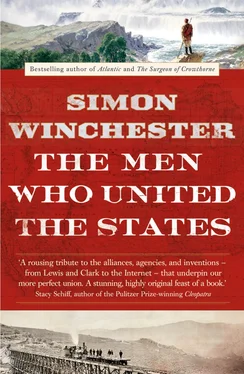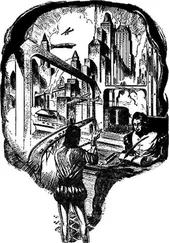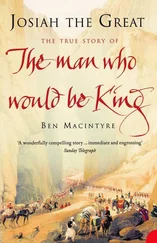The small southwestern Indiana town of New Harmony is not much to see these days—just a clutch of frame houses on the banks of the slow-drifting Wabash River. It is neat and tidy, quiet and peaceful. Nine hundred or so people live there, deep in the lush countryside where Kentucky, Illinois, and Indiana meet, down in the broad alluvial farmlands of the Ohio and the Mississippi Rivers that sidle past, not too far away.
A closer look at the town will hint at links with an interesting past. There is a museum designed by Richard Meier; a roofless church of curious design, which turns out to have been built by Philip Johnson; and a pair of spectacular gates designed by the cubist sculptor Jacques Lipchitz. All were created to memorialize that brief time in the early nineteenth century when New Harmony, as its name might now suggest, was founded to be the spiritual center of a great social experiment.
It was among the earliest of a scattering of similarly optimistic, hope-filled communities that sprang up in the early days of the United States, but New Harmony enjoyed a peculiar connection with that most elemental and unifying aspect of the stripling American nation: its geology.

To understand the geology of a country is to understand and then to realize all of its possibilities—its wealth, its strengths, the nature and kinds and value of its resources. Geology, after all, and without any intended pun, underlies everything. Human settlement on an unknown landscape perforce depends on a deep knowledge of what and where is potentially being settled—on whether the geology of this region suits it to farming, to mining, or to industry heavy or light; whether this range of hills is traversable, this cold prairie is cultivable, this wide river is fordable.
There can be no gainsaying the importance of the first crude discoveries made by the geological pioneers of early America: their findings, surveys, maps, and forecasts were the guides and lures that tempted and then scattered millions of people across the country. Eighteenth-century geology, infant science though it still may have been, offered the keys to unlock the country’s promise, bringing men out to inhabit the farther reaches of this country and create their nation.
And the town of New Harmony, Indiana, was where this realization of geology’s importance was born.
The town, first simply named Harmonie, was settled initially by early-nineteenth-century Germans, men and women fleeing to America much as the Pilgrim Fathers had fled two centuries before, to escape religious restrictions back home. Their piety and hard work paid off quickly, and they eventually moved on to larger quarters, selling their tiny settlement to another idealist adventurer, the campaigning Welsh socialist Robert Owen. He, flushed with the success of a millworkers’ commune that he had organized outside Edinburgh, planned to establish a utopian beachhead in America, based on socialist ideals. He renamed the former German village New Harmony; and once he had settled during the winter of 1825, he invited like-minded idealists to join him.
Such was the educational reputation of Owen’s earlier Scottish experiment that New Harmony became an immediate magnet for intellectuals, philosophers, teachers—and, in particular, scientists. Geologists, most notably, pitched in with a special enthusiasm, such that at the peak of New Harmony’s fortunes, no fewer than seven geologists of considerable later distinction could be counted among the inhabitants.
This tiny town briefly became “a scientific center of national significance,” as the University of Southern Indiana describes it today. New Harmony can fairly be regarded more specifically as the birthplace of American geology—not least because Robert Owen’s closest colleague and ideological soul mate, an equally eccentric visionary who came to join him on the banks of the Wabash River, is generally acknowledged today to be American geology’s founding father. He, too, was a foreigner, a middle-aged Scotsman of wealth and distinction whose fortune was in no way connected to the science of the earth—William Maclure.
THE SCIENCE THAT CHANGED AMERICA
Robert Owen and William Maclure were both strange and remarkable men. Owen was a social reformer of lasting repute—though his fame remains largely in his home country, to which he eventually returned. But when it comes to the story of geology as a unifying force in the making of the United States, the person of William Maclure is the one to be remembered preeminently—even though, ironically, he was not really a geologist at all.
Maclure, born in southern Scotland in 1763, was by his early thirties already a very rich man. He had amassed a fortune as a trader, helped by the annuity from his equally successful Ayrshire father, in whose mercantile footsteps he followed. He had come to the American colonies when he was a teenager, had set up his own import-export business when he was only nineteen, and soon afterward, profoundly influenced by the revolutionary events of 1776 and 1789 in America and France, moved to Philadelphia, throwing in his lot with a society that seemed to him to embrace his own beliefs in fairness and equality. He assumed American citizenship in 1796 and promptly established himself as a fully paid-up member of Pennsylvania’s fast-growing patrician society.
William Maclure, the wealthy Scotsman whose immense fortune allowed him time to indulge an early passion for American geology, and who in 1809 drew the country’s—and the world’s—first geological map.
Except that being merely patrician held little interest for a man of such a restless nature. No more than a year after becoming a citizen, when he might otherwise have started to enjoy the sedate comforts of early middle age, he made two important decisions.
He first decided to devote much of his remaining life to promoting educational reforms among America’s working classes. He vowed, as Robert Owen had already vowed, unbeknownst to Maclure, that the farmer, the miller, and the forge master would each have the same access to society’s potential as he and his wealthy peers had already been granted. It might take him years, but he would at least now begin to make plans.
At thirty-six, he believed himself young enough and fit enough to take on such a challenge. He had already achieved great eminence among the East Coast thoughtful: he was a leading light in the fiercely intellectual American Philosophical Society, founded by Benjamin Franklin, and would later go on to help found and run the American Academy of Natural Sciences, the oldest such institution in the country today. He believed deeply in the unifying powers of democratized science.
His second idea was more precise, as he explained in a letter to a friend. He “adopted rock-hunting as an amusement.” Geology, he declared, was far preferable to the conventional bourgeois pursuits of hunting and fishing, not least because it was “most applicable to useful practical purposes.” Moreover, “it has always appeared to me that the science of geology was one of the simplest and easiest to acquire: the number of names to be learned is small, and the present nomenclature, although rather generic than specific, is not difficult.”
He first toyed with the science during a brief stay in Europe, delving into the small mysteries of its nomenclature at the very time when the numerous schisms that plagued the calling were at their most dramatic. Perhaps no science has ever been caught up in such turmoil. On the one hand, geologists were busily unleashing themselves from centuries of dogmatic interference from the church. The less pious of their number were no longer content to believe unquestioningly in such literal Bible-based teachings as the creation of the earth on a precise October date in 4004 BC, for instance.
Читать дальше













